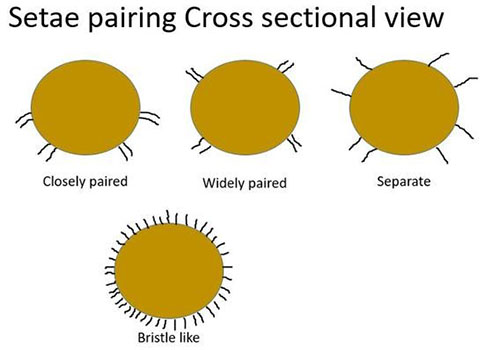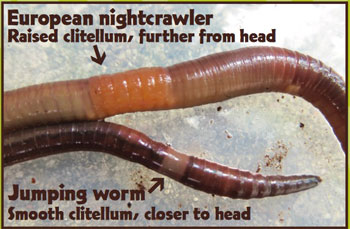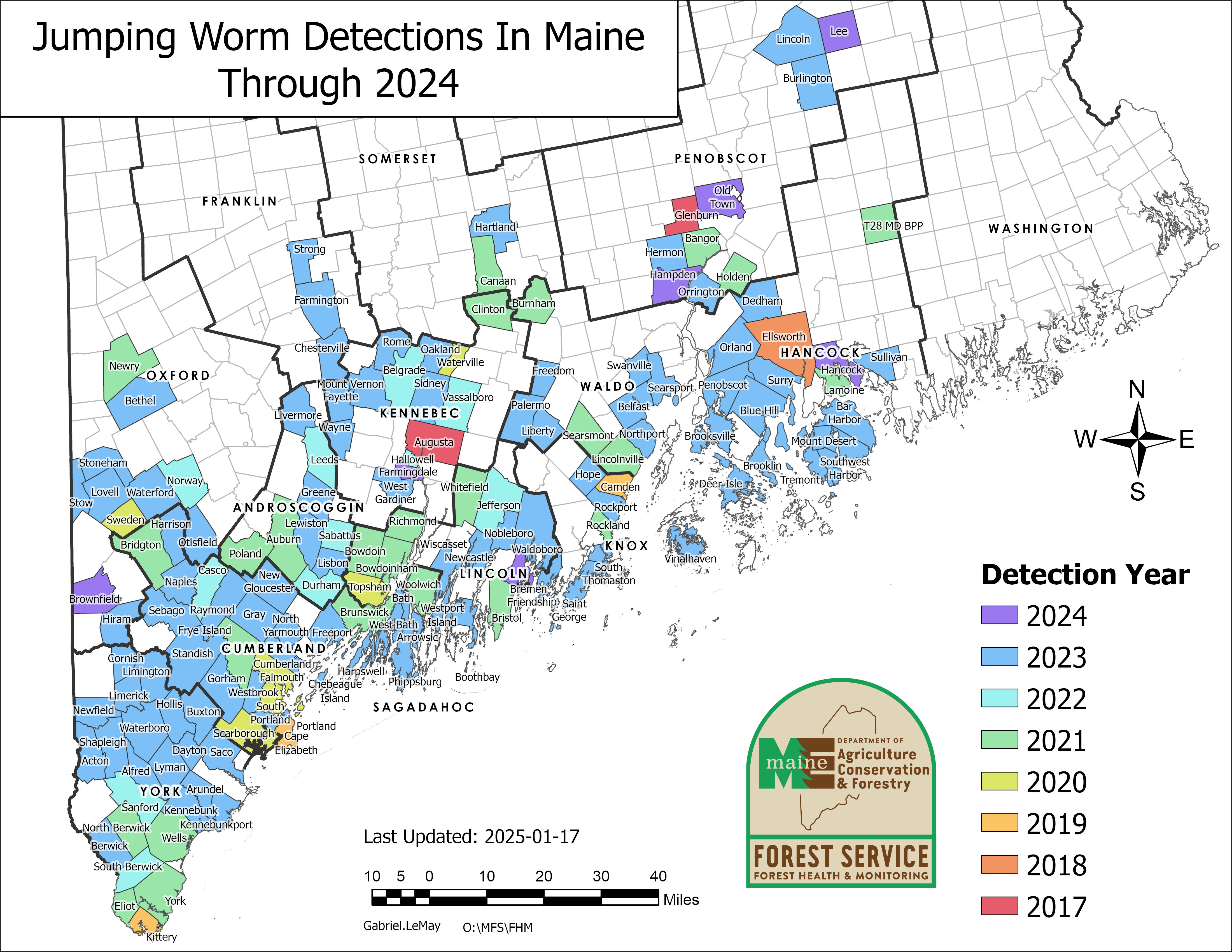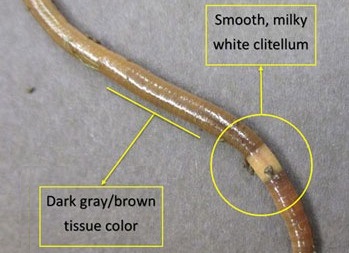DACF Home → Bureaus & Programs → Bureau of Agriculture → Division of Animal and Plant Health → Horticulture → Grower Resources → Amynthas Worms in Maine
Jumping/Snake (Amynthas) Worms in Maine
On this page:
- What are Amynthas Worms?
- History in Maine
- Why are Amynthas Worms a problem?
- Amynthas Worm Identification
- What can you do?
What are Amynthas Worms?
Due to our history of glaciation, there are no native earthworms in Maine. Non-native earthworms from Europe (such as nightcrawlers) have become well established here through early colonial trading. Though they are beneficial to our gardens, earthworms can have destructive effects on our forests.
Amynthas worms are a type of earthworm native to East Asia. They are smaller than nightcrawlers, reproduce rapidly, are much more active, and have a more voracious appetite. This rapid life cycle and ability to reproduce asexually gives them a competitive edge over native organisms, and even over nightcrawlers. When disturbed, Amynthas worms jump and thrash about, behaving like a threatened snake.
Amynthas worms are known and sold for bait and composting under a variety of names including snake worms, Alabama jumper, jumping worms, Asian Amynthas worm. They are in the genus Amynthas, and distinguishing between the several species in the genus can be difficult. All species in this genus are considered invasive in Maine. It is illegal to import them into Maine (or to propagate or possess them) without a wildlife importation permit from the Maine Department of Inland Fisheries and Wildlife (MDIFW).
For more information, visit MDIFW's Fish & Wildlife in Captivity webpage.
For further reading and educational materials, check out the Jumping Worms guide from Oregon State.
History in Maine
Amynthas worms are native to Korea and Japan, and are now found in the United States from Maine to South Carolina and west to Wisconsin. Amynthas worms were first collected from a Maine greenhouse in 1952, though an established population of this active and damaging pest was not discovered here until about 2014 when two populations were discovered in Augusta (one at the Viles Arboretum) and two populations were found in Portland. They have also been found in a rhododendron display at the Coastal Maine Botanical Gardens in Boothbay. Amynthas are now considered to be widespread and found in 13 of the 16 counties.
Why are Amynthas Worms a Problem?
Amynthas worms change the soil by accelerating the decomposition of leaf litter on the forest floor. They turn good soil into grainy, dry worm castings (aka poop) that cannot support the native understory plants of our forests. Other native plants, fungi, invertebrates, and vertebrates may decline because the forest and its soils can no longer support them. As native species decline, invasive plants may take their place and further exacerbate the loss of species diversity.
In nurseries and greenhouses, Amynthas worms reduce the functionality of soils and planting media and cause severe drought symptoms. After irrigating or rains, you may find these worms under pots. These worms may be inadvertently moved to new areas with nursery stock, or in soil, mulch, or compost.
Many of Maine's forests are already under pressure from invasive insect pests, invasive plants, pathogens, and diseases. Amynthas worms may cause long-term effects on our forests.
Amynthas Worm Identification
- When handled, they act crazy, jump and thrash about, behaving more like a threatened snake than a nightcrawler, Video of jumping worm wriggling
- May shed their tail when handled, Video of jumping worm tail detachment
- Immature worms (seen April – late June) do not have the clitellum but can be identified by the setae (bristles) that encircle their bodies. (see illustration below
- Clitellum (the band around their body) is milky white, smooth, and flat to their body
- Often found in groups
- Soil looks very grainy at the surface, like coffee grounds
- Can reproduce by parthenogenisis (asexually), maturing in 60 days, allowing two hatches per season
- Annual species, but tiny cocoons overwinter in the soil
- Best time to find them is late June to mid-October
- In nurseries, they can often be found underneath pots that are sitting on the ground or on landscape fabric
- In forests, they tend to be near the surface, just under accumulations of slash or duff
- Identify and Report Jumping Worms in Maine (YouTube)
- Setae: Tiny hairs called setae are found around the earthworms body and help it move. European species have eight setae around each segment. The jumping worm has as many as 40 setae or more around each segment. (Photo Courtesy of University of Minnesota/Jumping Worms)

What can you do?

Amynthas Worm cocoon at yellow arrow, in granular castings, Photo by Marie Johnston, courtesy University of Wisconsin-Madison Arboretum
Monitoring and Prevention
- Monitor your property for jumping worms using the mustard method found under “Take Initiative” on this factsheet. If you find worms see the information below on reporting.
- Do not buy or use Amynthas worms for composting, vermicomposting, gardening, or bait.
- Do not discard live worms in the wild. Dispose of them (preferably dead) in the trash.
- When possible, buy bare root plants.
- Clean your tools and avoid worms moving in runoff water. Wash tools over a bucket to capture the soil, decanting the water after the soil settles. Then let the bucket stand to dry out. You can then put the soil in a plastic bag and solarize it before putting in compost.
- Be careful when sharing or moving plantings, cocoons may be in the soil.
- For land trusts, gardens, hiking trails, and anyone else who has found jumping worms on publicly accessed lands - consider adding signage and boot brushes at trail entrances to inform folks how to prevent the spread. There are signs available for purchase and boot brushes on NAISMA.
Reporting
- Report jumping worms using the Maine photo and information submission form, which works on desktop or mobile. Entries will be submitted to the iMapInvasives Public Database.
- If you suspect you obtained worms from compost or potted plants you purchased at a particular location, please do the following:
- Reach out to the location you believe you obtained them from and let them know you found these worms.
- Reach out to Gary Fish, State Horticulturalist, who will ensure that the proper channels are informed (Gary.Fish@maine.gov).
- Consider preserving some worms for future species verification. While DACF cannot guarantee identification services, you can store worms in a labeled plastic bag in the freezer or in a sealed jar with rubbing alcohol
- At this time, please understand that jumping worms are not a regulated invasive species in Maine, so DACF cannot take action beyond education about the organism.
Learn more!
- There is some early evidence that solarization of the soil to 104°F for 2 hours will kill the egg-containing cocoons; however, ongoing research is taking place to determine the best methods. Penn State Extension has some guidelines you can try. Unfortunately, re-infestation of the area may occur due to cocoon presence in areas beyond the treatment zone.
- Factsheet for Homeowners
- Best Practices for Plant Sale Donors and Buyers in Maine (UMaine Cooperative Extension)
- Plant Sale Recommendations to Reduce Jumping Worm Spread – University of Minnesota Extension (PDF)
- Invasive Jumping Worm Frequently Asked Questions
- Jumping Worm Factsheet for Composters (PDF)
- Jumping Worm Precautions for the Green Industry (PDF)
Questions?
| Name | Phone | |
|---|---|---|
| Gary Fish, State Horticulturist | gary.fish@maine.gov | 207-287-7545 |
| Hillary Peterson, IPM Entomologist | hillary.peterson@maine.gov | 207-215-4793 |


